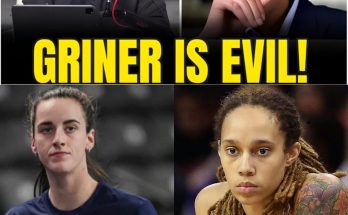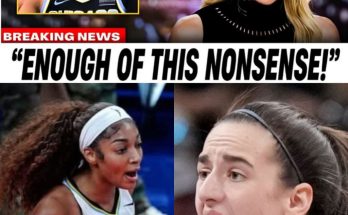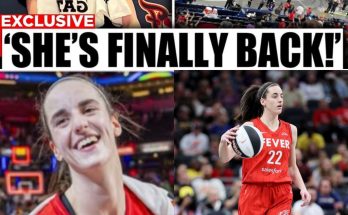
In a league where every move is scrutinized, every foul dissected, and every moment amplified by social media, one incident can change everything. For Diamond DeShields, that moment came on a seemingly routine night in the WNBA. What should have been another game between the Indiana Fever and the Chicago Sky turned into a career-altering spectacle, a cautionary tale of hubris, resentment, and the unrelenting power of the league’s new golden child, Caitlin Clark.
What followed was a firestorm of controversy, outrage, and consequences that no one could have predicted. The story of Diamond DeShields’ fall from grace is not just about one reckless play—it’s about the shifting dynamics of a league in transition, the rise of a new star, and the price of stepping out of line in the WNBA’s new era.
The game itself was unremarkable. The Indiana Fever were comfortably ahead, and the Chicago Sky were struggling to keep up. But with one play, Diamond DeShields made sure no one would forget that night. Caitlin Clark, the WNBA’s brightest new star, was cutting through the lane, just another routine possession. But instead of defending her, DeShields lowered her shoulder and barreled into Clark like a linebacker. It wasn’t a defensive play—it was a statement. The crowd gasped, the cameras zoomed in, and social media exploded.
This wasn’t just a foul. It was a calculated, deliberate act of aggression. DeShields didn’t even try to disguise it. She reached out a hand afterward in a mock gesture of sportsmanship, but no one was fooled. The crowd booed, analysts replayed the hit from every angle, and fans flooded social media with outrage. It was clear to everyone watching: this wasn’t basketball. This was personal.
Caitlin Clark, to her credit, got up, dusted herself off, and kept playing. But the damage was done—not to her, but to Diamond DeShields. In that moment, DeShields didn’t just commit a foul; she crossed an invisible line, one that the WNBA had drawn around its most marketable and beloved player. And the consequences would be swift and severe.
To understand why this moment was so significant, you have to understand who Caitlin Clark is. She’s not just a player; she’s a phenomenon. From the moment she entered the league, Clark has been a game-changer. Her incredible shooting range, Steph Curry-like ability to create highlights, and fiery competitiveness have made her the face of the WNBA almost overnight. She’s brought in record-breaking viewership, sold-out arenas, and a level of attention the league has never seen before.
But with that fame comes a target. Clark’s rapid rise has made her a polarizing figure. To her fans, she’s a generational talent, the player who will take women’s basketball to new heights. To her detractors, she’s a symbol of everything they resent: a young, white player from Iowa who walked into a predominantly Black league and immediately became its biggest star. The whispers of jealousy and resentment have been growing louder, and on that night, Diamond DeShields gave those feelings a physical manifestation.
What happened next was unprecedented. At first, the WNBA stayed silent. There was no technical foul, no flagrant, no ejection. The referees acted as if they hadn’t seen the hit, and the league didn’t issue any immediate statements. But fans weren’t willing to let it go. Social media erupted, with replays of the hit flooding every platform. Analysts and former players weighed in, calling it a cheap shot, a dirty play, and an attack on the league’s brightest star.
The outrage reached a boiling point, and the WNBA had no choice but to act. Behind the scenes, the consequences for DeShields were already brewing. Her minutes started to dwindle. Her role on the Chicago Sky shrank until she was quietly let go. There was no press release, no thank-you post, just a quiet exit that spoke volumes. The New York Liberty gave her a second chance, but it didn’t last. She was waived just as quickly as she was signed. Finally, the Connecticut Sun picked her up late in the preseason, but even that lifeline was short-lived. One day before the season opener, DeShields was cut again.
By this point, it was clear: this wasn’t just about roster moves. Diamond DeShields had been blacklisted. The league didn’t just bench her—they slammed the door shut, locked it, and threw away the key. No team was willing to take a chance on her, and her career in the WNBA was effectively over.
As the reality of her situation set in, DeShields took to social media to share her heartbreak. In a raw and emotional post, she revealed how she had driven to Connecticut with all her belongings, only to be cut just hours before the season began. “The team will ship three to five boxes,” she wrote, “but I have way more than that.” The post was accompanied by a blurry selfie and a caption that reeked of defeat. It was a far cry from the confident, fiery competitor fans had once known.
But the internet was unforgiving. Instead of sympathy, DeShields was met with ridicule. Comments like “Play stupid games, win stupid prizes” flooded her post. For many fans, this wasn’t a tragedy—it was justice. DeShields had taken a cheap shot at the league’s most beloved player, and now she was paying the price.
The story of Diamond DeShields and Caitlin Clark is about more than just one hit. It’s about the shifting dynamics of the WNBA and the tensions that come with it. Clark’s rise has brought unprecedented attention to the league, but it has also exposed cracks in its culture. Many players, particularly veterans, feel overshadowed by Clark’s sudden stardom. They’ve spent years grinding in relative obscurity, only to see a rookie walk in and become the face of the league.
And then there’s the elephant in the room: race. Clark’s status as a white phenom in a predominantly Black league has added another layer of complexity to her story. Some see her as a symbol of privilege, someone who has benefited from the media’s obsession with marketable stars. Others argue that her talent speaks for itself and that the resentment she faces is rooted in jealousy, not race.
Whatever the reason, the result is the same: Clark has become a lightning rod for controversy. Every hard foul, every snub, every cryptic tweet adds fuel to the fire. And while Clark herself has stayed quiet, letting her game do the talking, the league has been forced to confront the tensions her presence has brought to the surface.
The fallout from the DeShields incident has left the WNBA at a crossroads. The league is growing, attracting new fans and breaking viewership records, but it’s also facing growing pains. The rise of Caitlin Clark has brought new opportunities, but it has also highlighted old resentments. The league now has to decide what kind of future it wants to build.
For Diamond DeShields, that decision came too late. Her career is over, not because she lacked talent, but because she couldn’t adapt to the league’s new reality. She chose to take out her frustrations on the face of the league, and the league responded by showing her the door.
As the dust settles, one thing is clear: the Caitlin Clark era is here. She’s not just a player; she’s a movement. Her presence has raised the bar for the league, both on and off the court. And while her rise has been met with resistance, it has also forced the WNBA to evolve.
For players like DeShields, the message is clear: if you can’t keep up, you’ll be left behind. The league is choosing its future over its past, its stars over its grudges. And Caitlin Clark isn’t just the present—she’s the blueprint.
Diamond DeShields’ story is a cautionary tale, a reminder of what happens when resentment and ego outweigh talent and professionalism. But it’s also a turning point for the WNBA, a moment that will define its future. The league is growing, and it’s not waiting for anyone who refuses to grow with it.



